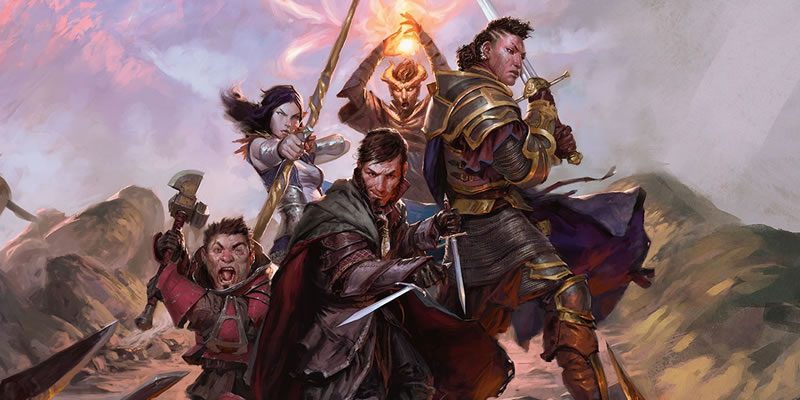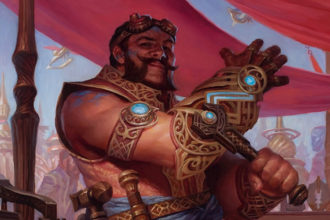Unearthed Arcana: Dragonmarks Breakdown

Back when I wrote my breakdown of the Wayfinder’s Guide to Eberron, I stayed fairly high-level on studying the dragonmarks. At the time, this was because WGtE is a big document and I wanted to cover it in a single article. Turns out, it also means I have something to talk about today!
Basic Structure
As I mentioned in the first article, the core structure of dragonmarks is replacement of racial features. The amount of replacement varies by the dragonmark. There’s a new mechanic called the Intuition die that functions a lot like permanent guidance for a single skill or tool proficiency. There are things you can do to improve the die size, such as buying the Greater Dragonmark feat and some not-yet-revealed sources. As you’d expect, basic and greater dragonmarks grant various magical abilities.
You may recall that the 3.5 Eberron Campaign Setting had examples of each dragonmark at each level of development. This document offers a d6 table describing unusual appearance, texture, and so on of your personal mark.
Mark of Detection
Keep in mind that this Mark only appears on half-elves.
- In place of +2 Cha and +1 to two other stats, you gain +1 Int, +1 Cha, and +1 to one other stat. It’s a noticeable but not crushing net loss.
- In place of Skill Versatility (proficiency in any two skills you like), you gain Deductive Intuition, so that you add your Intuition die to Int (Investigation) and Wis (Insight) checks; and Sense Threats, allowing you to cast detect magic and detect poison and disease as rituals.
- You lose your unassigned language proficiency.
Well, I can’t make an argument that it’s overpowered, and I don’t think it’s underpowered either. It tells its story in a straightforward way and grants rituals that you’ll never be sad to have available. Looks solid to me. I’m guessing 95% of all players don’t so much as notice the loss of an extra language. The Greater Mark of Detection grants see invisibility and true seeing 1/long rest, which is just about the earliest you’re ever going to get true seeing – and an extra casting of see invisibility never led anyone astray.
Mark of Finding
Superficially, Detection and Finding seem like they’re covering all the same ground, but I’ve always loved that Eberron is good about creating significant daylight between those concepts. This is for half-orc bounty hunters, most of all.
Note: This document cuts humans out of the Mark of Finding and House Tharashk, in contrast with 3.x Eberron, 4e Eberron, and WGtE. Make of that what you will. It’s not a piece of Eberron canon that I wanted to see change, personally.
- In place of +2 Str and +1 Con, you gain +1 Str, +1 Wis, and +1 to one other stat.
- In place of Menacing (proficiency in Intimidation), you gain Hunter’s Intuition, adding your Intuition die to Wis (Perception) and Wis (Survival).
- In place of Relentless Endurance, you gain Imprint Prey. Imprint Prey is a fairly involved ability, but it boils down to heightening your Hunter’s Intuition against a single target that you can see, or that you are tracking with Wis (Survival). You further ignore up to half cover for that target, and if you are blind or it is invisible, you negate its advantages against you. This won’t come up that often, but when it does, you probably feel real cool doing it.
- Nature’s Voice at 3rd level replaces Savage Attacker, and lets you cast locate animals and plants as a ritual. This is a fairly forgettable ability, unless you’re a wilderness guide in a desert or similarly harsh terrain.
Overall, I think this is a great collection of abilities. It won’t come up as often as the core half-orc features, unless the campaign is all about tracking people down (which is, in fairness, a common part of any crime procedural). The story it tells about this “subrace” of half-orcs is compelling. I might like to see slightly broader combat appeal, but there’s probably no skill more in demand than Perception, so the payoff is good. I’m not all that into locate creature and find the path from the Greater Mark of Finding, admittedly – they’re good for the concept, but I haven’t yet forgiven find the path for being ruin the adventure in 3.x, even though it’s much less bad about that now. Getting good usage out of locate creature also takes a mighty specific situation. You can afford to give this Greater Dragonmark a miss.
Mark of Handling
The Mark of (Animal) Handling is for humans.
- In place of +1 to each stat, you gain +1 to Dex, Wis, and one score of your choice.
- Wild Intuition lets you add your Intuition die to Wis (Animal Handling) or Int (Nature) checks. Nice to have, but they don’t come up that often in games, as far as I’ve seen.
- Expert Handling lets you use Aid Another on animal companions or mounts from a distance.
- Primal Connection lets you cast animal friendship 1/short rest. Animal friendship is a heavily underrated spell, so make the most of this.
- The Bigger They Are lets you treat low-Int monstrosities as beasts when targeting your spells. Even without a spellcasting class, this is great, but one dominate beast and you, my friend, are off to the races. (Hint: the Greater Mark of Handling grants dominate beast, because of course it does. Also, beast sense.)
The core concept of this Mark didn’t sound like something I’d be anxious to play, but once I get into the features, it wins me over. Nothing sells the awesomeness of this Mark quite as hard as The Bigger They Are.
Mark of Healing
I love playing healers anyway, and I’m a pretty easy sell on halflings, overall. These aren’t your rotund homebody hobbits or your hyperactive kleptomaniacs – you might say they reject the kender binary. These features replace only the subrace features.
- +1 Wis.
- Medical Intuition grants use of your Intuition die on Wis (Medicine) checks. You probably know without me telling you that this won’t come up much. That said, if you’re playing a Sharn General Hospital procedural, please tell me all about it in the comments.
- Healing Touch gives you a very limited ability to heal by laying on hands, sort of: you expend your hit die, add your Wisdom bonus, and restore that number of hit points to one creature, once per short rest. It should stand you in good stead over the course of play.
- Jorasco’s Blessing grants the spare the dying cantrip, which is at least marginally better than not having it, but that’s about it.
I expect that Medical Intuition and Jorasco’s Blessing don’t get a whole lot of the job done for anyone, since their functions overlap on each other so much and Healing Touch does most of the same job. If they take another pass at this one, I’d like to see some improved benefit to using healer’s kits. The Greater Mark of Healing does pick up a fair bit of the slack there with mass cure wounds and greater restoration. Still – some improvement to an ally’s saves against ongoing poison or healing during short rests would go a long way here.
Mark of Hospitality
This is the other halfling Mark, and one I’ve always seen as great to have in the world but tough to want to play as your PC. As before, this replaces your subrace.
- +1 Cha.
- Innkeeper’s Charms grants the friends and prestidigitation See the comments from my WGtE breakdown for a note about how they meant to have friends not suck for the Mark of Hospitality, because its normal drawback is completely tone-deaf for the innkeeper, even more so than its usual trickster-ish uses.
- Ever Hospitable lets you apply your Intuition die to Cha (Persuasion) checks, and checks with brewer’s supplies or cook’s utensils. Make sure you pair this with the expanded tool functions of XGTE.
This is… underwhelming, even for a subrace. The Greater Mark of Hospitality is going to rescue it some, in that Mordenkainen’s magnificent mansion is incredible, but you’ll still need a DM and fellow players that are highly committed to helping you make your concept work to have fun with this.
Mark of Making
Totally apart from the features of this Mark, House Cannith has one of my favorite stories of the Dragonmarked Houses. They have more explicit moral ambiguity than anyone but the Houses of Shadow (which I also love). This is a human house.
- +1 Int, +1 Dex, and a further +1 to either Int or Dex.
- Artisan’s Intuition lets you add your Intuition die to rolls with artisan’s tools. Of course, rolling checks with artisan’s tools isn’t a significant part of official crafting systems.
- Maker’s Gift grants the mending cantrip and proficiency in one type of artisan’s tools.
- Magecraft lets you make a temporary magic item, with which you can cast one wizard cantrip. This is a neat idea. I don’t think I have it in me to pass up a lightning lure item, even if there are more powerful cantrips out there.
- Spellsmith lets you make one weapon or suit of armor a +1 item for one hour, 1/long rest. This is a pretty great feature any way you slice it.
Artisan’s Intuition and Maker’s Gift are situational, but you’ll almost certainly find some great options for Magecraft and Spellsmith. They’re redundant for wizards like Merrix himself, though. The Greater Mark of Making is still redundant for wizards, but fabricate and creation can be incredible problem-solving multitools if you’re willing to think things through.
Mark of Passage
House Orien is a human house. I haven’t dug into their story all that much, but their lightning rail is one of the most memorable parts of Eberron’s aesthetic.
- +2 Dex, and +1 to one other score of your choice.
- Courier’s Speed increases your walking speed to 40. Very strong right off the bat.
- Intuitive Motion lets you use your Intuition die on Str (Athletics) checks and land vehicle checks. You’re a grappler and a wheelman? Very nice. (Let’s hope some of those vehicle checks use your Dex, or there’s an aggravating stat mismatch.)
- Orien’s Grace lets you spend half of your movement for the turn to avoid triggering opportunity attacks in the rest of that turn. Note: This is significantly different from the feature in WGtE, which let you ignore difficult terrain if you Dashed during your turn.
- Shared Passage is a sight-range, bonus-action teleport for you and one willing creature, 1/long rest. I foresee vast potential for shenanigans here.
This is definitely one of the strongest Marks in the document. Every one of these features has clear uses and comes up in the normal course of gameplay. The Greater Mark of Passage adds in blink and teleportation circle, so… I think we can call this one a wrap. It’s just the best.
Mark of Scribing
House Sivis is exclusively gnomish, and once again we’re looking at subrace replacement.
- +1 Cha.
- Gifted Scribe grants proficiency with calligraphy and forgery kits, and lets you apply your Intuition die to checks with them.
- Scribe’s Insight lets you cast comprehend languages 1/long rest.
- Whispering Wind grants the message
- Extra Language grants fluency in, er, an extra language.
Keeping in mind again that it’s a subrace, this is fine. It tells the story of House Sivis, and it grants things that won’t come up all the time, but that you can work on building plans around. The Greater Mark of Scribing grants sending and tongues, both 1/short rest. My experience suggests that sending becomes incredibly useful the moment you have it.
Mark of Sentinel
House Deneith is a human house of bodyguards, soldiers, mercenaries, and gladiators.
- +1 Str, +1 Wis, +1 to any score.
- Sentinel’s Intuition lets you add your Intuition die to initiative checks and Wis (Perception) checks, but only if the Perception check is about noticing a threat. Still, you’ll use this at least once per fight, so it’s great.
- Sentinel’s Shield grants the blade ward cantrip, which is mostly terrible. It also lets you cast shield 1/short rest, which is amazing.
- Vigilant Guardian needed someone to be a bit more vigilant about typos, but that’s life on a tight production schedule. Looking to WGtE, then, it lets you choose one person to focus your attention on defending, and grants advantage to Wis (Insight) and Wis (Perception) checks you make in that effort. Further, you can block attacks aimed at your ward with your own body, trading places with them and making yourself the target, if you’re within 5 feet. Used correctly, this is master-level tanking.
This Mark isn’t as dominating for its playstyle as the Mark of Passage, but it’s still very good. There are some class/subclass combinations that rescue blade ward from ignominy – anything that lets you combine casting a cantrip and making one or more attacks could go somewhere. Compelled duel and warding bond from the Greater Mark of Sentinel are good to have and on-message.
Mark of Shadow
This is an elven house of assassins, spies, and entertainers. Its features replace your subrace.
- +1 Cha.
- Natural Talent grants proficiency in either a musical instrument or the Performance skill.
- Gift of the Shadows lets you apply your Intuition die to Cha (Performance) and Dex (Stealth) checks.
- Shape Shadows grants the minor illusion
- Slip into Shadow is a special Hide bonus action that doesn’t require cover, concealment, or being unobserved, but you can only attempt it once per short rest. This is phenomenal.
This collection of features certainly demonstrates the two faces of the Mark of Shadow, and it looks very potent. Considering how much criticism I have for existing elf subrace features, this is comparatively insanely OP, but I’d rather see high elves brought up to this standard than other elf subraces get nerfed. The Greater Mark of Shadow offers nondetection and mislead, which are both great if you’re having the kinds of problems that a spy or assassin should be having, and merely pretty good if you’re having more typical adventurer problems.
Mark of Storm
This is a half-elven house, so it’s a partial replacement of racial features.
- +1 Dex, +1 Cha, +1 to a score of your choice – so a net loss of one ability score point.
- Sea Monkey grants a 30-foot swimming speed.
- Windwright’s Intuition lets you add your Intuition die to Dex (Acrobatics) checks and air or water vehicle checks.
- Storm’s Blessing grants resistance to lightning damage. Well, that’s obviously great.
- Headwinds grants the gust cantrip and, at 3rd level, gust of wind 1/long rest. I have to keep reminding myself that gust of wind has gotten a lot more useful in 5e than it has ever been before, so this is a pretty good feature.
- You lose your one unassigned language fluency.
Considering that this only cost you one ability score point and your Skill Versatility, this looks great to me. Don’t get me wrong, Skill Versatility is a high cost, but the things you get for it are no joke. The Greater Mark of Storm adds control water and control wind. I’m taking it as read that control wind means control winds from the Elemental Evil Player’s Companion. Both of these spells are highly situational, but if it gets you thinking of cool ways to use them, so much the better. This might be one of the dragonmarks where you’d consider skipping the Greater Dragonmark feat.
Mark of Warding
This is the one dwarven Mark, and replaces your subrace.
- +1 Dex and +1 Int. Nice!
- Master of Locks lets you add your Intuition die to Int (History), Int (Investigation), and thieves’ tools checks relating to locks and traps.
- Wards and Seals lets you cast alarm as a ritual, and at 3rd level you can cast arcane lock 1/long rest.
These Mark features are fine, maybe not the very most eye-catching. The extra ability score point helps. It does make me want to play a dwarf rogue. The Greater Mark of Warding adds knock, glyph of warding, and Leomund’s secret chest 1/long rest, and that’s a pretty great expansion to the B&E/security concept. I would give this a shot.
Aberrant Dragonmarks
The first thing to understand is that aberrant dragonmarks are real bad for you, in a fun way. Having to wait until 4th level (unless you’re a Variant Human) to start this story is kind of unfortunate, but it suggests a few things about human genetics that I rather like. Again, this is a feat, not a race or subrace replacement.
- +1 Con.
- Gain a cantrip and a 1st-level spell from the sorcerer spell list. You can cast the 1st-level spell once per long rest. Con is your spellcasting ability, which is kind of interesting.
- You can heighten that 1st-level spell by burning Hit Dice and taking some damage for the privilege. I adore this mechanic.
Overall it’s a variant on Magic Initiate that lets you boost your 1/long rest spell, and learns one less cantrip but gains a point of Con. It’s better than Magic Initiate, but it’s also a story-starting feat that will make your life harder in Eberron, so I think it’s fine. I think the Aberrant Mark Flaw table has some pretty good teeth.
Conclusion
In brief, I’m surprised there were any changes from the WGtE document. If every word of this became the final design, it would be fine. I wouldn’t mind seeing some tweaks to the Marks of Healing and Hospitality, in my most ideal world.



